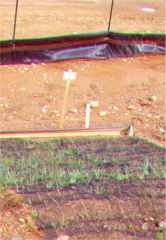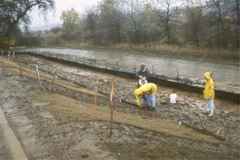SHASTA COLLEGE EROSION CONTROL BLANKET
STUDY
Research by Community College Quantifies Erosion from Slopes
By Vance Howard and John McCullah
(This article was published in "Land and Water" magazine)
To see more photos of the blanket study, 
Introduction
In the fall of 1998, Shasta Community College (Redding, California)
implemented a comparative study of thirteen different erosion
control blankets. Greenfix America provided the funding
for the study. Greenfix America and Reed and Graham,
Inc. (Sacramento, California) provided erosion control blankets.
Manufacturers included Greenfix America, American Excelsior,
Xcel, North and American Green. Instructors and students
from various classes, including Watershed Restoration, Heavy
Equipment Operation, Soils, Ecosystem Inventory, and Natural
Resources Statistics, conducted the study from October 1998
through June 1999. One of the most notable results of
the study was that on average the blankets provided an 81%
reduction in soil loss. Also noteworthy was the average
soil loss of the equivalent of nearly 25 tons/acre on the
bare soil plots, with no observed rills or gullies.
Site
A site on the Shasta Community College campus in Redding,
California was chosen for the study. The study was conducted
on the outer slope of the levee of a recently constructed
water treatment detention pond. The study area was graded
and “track walked” to ensure a uniform soil surface.
Additionally, the slope was raked by hand to create a uniform
seedbed. The slope was set to a gradient of 1 ¾
: 1, or approximately 60%. Slope length was approximately
16 feet. The slope was de-compacted to a depth of 6-8
inches. The soil type for the study area was classified
by the Soil Survey for Shasta County as Churn Loam (CdA).
The slope aspect was northeast.
Study
 The purpose
of the study was to test the effectiveness of the blankets
to prevent erosion, aid in grass seed germination, and also
to test the durability of the blankets. The durability
test was not conducted, as we were unable to obtain the proper
instrumentation necessary to perform this part of the study.
This paper will focus on the erosion (soil loss) portion of
the study. A total of 15 study plots were created at
the site. All plots were seeded with Elymus glaucus
(blue wild rye), a local native grass, at a rate of 40#/acre.
A total of 12 different blankets were installed in October
1998 by Shasta College faculty and students. The blankets
were installed using the manufacturers instructions and under
the supervision of a Certified Professional Erosion Control
Specialist (CPECS). All blankets were installed at a
length of 14 feet and width of 8 feet. The tops of the
blankets were keyed-in at the top of the slope. One
plot was mulched with straw mulch and two plots were left
as controls (bare soil with seed only). The purpose
of the study was to test the effectiveness of the blankets
to prevent erosion, aid in grass seed germination, and also
to test the durability of the blankets. The durability
test was not conducted, as we were unable to obtain the proper
instrumentation necessary to perform this part of the study.
This paper will focus on the erosion (soil loss) portion of
the study. A total of 15 study plots were created at
the site. All plots were seeded with Elymus glaucus
(blue wild rye), a local native grass, at a rate of 40#/acre.
A total of 12 different blankets were installed in October
1998 by Shasta College faculty and students. The blankets
were installed using the manufacturers instructions and under
the supervision of a Certified Professional Erosion Control
Specialist (CPECS). All blankets were installed at a
length of 14 feet and width of 8 feet. The tops of the
blankets were keyed-in at the top of the slope. One
plot was mulched with straw mulch and two plots were left
as controls (bare soil with seed only).
Before the first winter storm of 1998-‘99, sediment
collection troughs were installed at the base of each study
plot. The collection trough was a pre-manufactured 11”
deep continuous/(seamless) gutter, 6 feet long, with end caps
and a downspout nipple. The 3” flange on the gutters
was pounded into the slope to ensure the sediment-laden runoff
went into the trough, not under. The gutters were installed
with a 1-2% drop towards the downspout. A filter fabric
screen was fastened to the outer end of the downspout to keep
sediment from escaping.
Results
 The troughs were emptied
by hand a total of four times throughout the winter season
(specified by city ordinance to be Oct. 15th – June
1st for construction purposes). Five gallon buckets
were labeled and assigned to each plot for storage of the
sediment collected from the troughs. At the end of the
winter season the depth of the sediment in each bucket was
measured and a volume of sediment was calculated for each
plot. The dry weight for a sample of soil with a known
volume was determined. The dry weight for the sediment
from each plot was calculated (in tons). The area of
each plot was the same (112 sq. ft.) and was converted to
acres. Soil loss was determined for each plot and is
presented as tons/acre. The troughs were emptied
by hand a total of four times throughout the winter season
(specified by city ordinance to be Oct. 15th – June
1st for construction purposes). Five gallon buckets
were labeled and assigned to each plot for storage of the
sediment collected from the troughs. At the end of the
winter season the depth of the sediment in each bucket was
measured and a volume of sediment was calculated for each
plot. The dry weight for a sample of soil with a known
volume was determined. The dry weight for the sediment
from each plot was calculated (in tons). The area of
each plot was the same (112 sq. ft.) and was converted to
acres. Soil loss was determined for each plot and is
presented as tons/acre.
Average soil loss from the blanketed and straw mulched plots
was 4.71 tons/acre, with a range from 3.09 to 7.36 tons/acre.
The two unblanketed control plots showed an average soil loss
of 24.83 tons/acre (23.04 and 26.61 tons/acre). It is
important to note that no rills or gullies formed on the control
plots. Also noteworthy is that the blankets resulted
in an 81% reduction in soil loss compared to bare soil.
Conclusions
The results of this study indicate that without proper erosion
control (blankets, mulching, etc.) on 60% slopes, approximately
25 tons/acre of soil (mostly fines) can be expected to be
lost without the typical indicators of erosion (rills and
gullies) even forming. This could be important information
for the development/construction industry, as well as the
public agencies that monitor and enforce the rules regulating
discharge of storm water off-site. |
